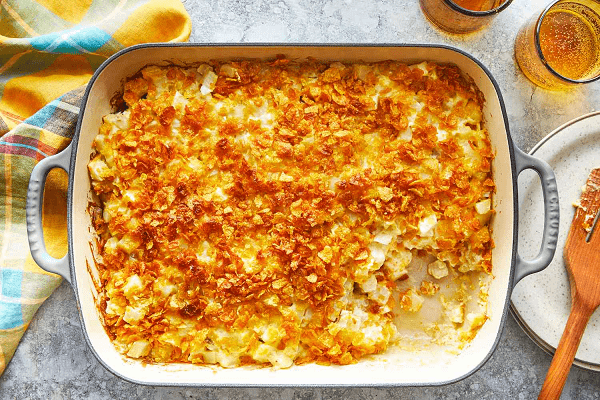Casseroles- Casseroles are popular one-dish meals that are baked and served in the same dish. They typically consist of a variety of ingredients, including meat, vegetables, starches, and a sauce, all baked together in an oven. Casseroles are known for their convenience and versatility, as they allow you to combine different ingredients in creative ways.
Here’s a basic guide on how to make a simple casserole:
Ingredients:
- Protein: Choose a protein source such as chicken, beef, turkey, or tofu.
- Vegetables: Include a mix of vegetables like carrots, peas, broccoli, bell peppers, or any other favorites.
- Starch: Add a starch component like pasta, rice, potatoes, or quinoa.
- Sauce: Use a sauce to bind the ingredients together. Options include cream-based sauces, tomato sauce, or broth-based sauces.
- Cheese (optional): Many casseroles are topped with cheese for added flavor and a golden crust.
Instructions:
- Preheat the Oven: Preheat your oven to the temperature specified in your recipe.
- Prepare Ingredients: Cook any raw ingredients like meat or pasta before assembling the casserole. Chop vegetables and prepare any other components.
- Assemble: In a casserole dish, layer the ingredients starting with the starch, followed by the protein, vegetables, and sauce. Mix everything well.
- Top with Cheese (optional): If you’re using cheese, sprinkle it on top of the casserole.
- Bake: Cover the casserole with foil and bake according to your recipe. Uncover for the last 10-15 minutes to allow the top to brown.
- Serve: Once the casserole is cooked through, let it rest for a few minutes before serving.
Popular Casserole Varieties:
- Chicken and Rice Casserole: Combines chicken, rice, vegetables, and a creamy sauce.
- Vegetarian Lasagna: Layers of pasta, ricotta, marinara sauce, and vegetables.
- Tuna Casserole: Features tuna, noodles, peas, and a creamy mushroom sauce.
- Shepherd’s Pie: Ground meat (usually lamb or beef) topped with mashed potatoes.
- Broccoli and Cheese Casserole: Combines broccoli, cheese sauce, and often a crunchy topping.
Casseroles are easily adaptable, so feel free to get creative and tailor them to your preferences. They are also great for using up leftovers and can be prepared ahead of time for busy weeknights.
What is Casseroles
A casserole is a culinary dish that is typically prepared in a single baking dish and cooked slowly in an oven. The term “casserole” can refer to both the dish itself and the food that is cooked inside it. Casseroles are known for their simplicity, as they usually involve layering ingredients in the baking dish and baking them together until they are thoroughly cooked.
Here are some key characteristics of casseroles:
- Single Dish Cooking: Casseroles are often prepared in a single dish, which can be a baking dish, casserole dish, or a similar oven-safe container. This makes for easy preparation and cleanup.
- Layered Ingredients: Casseroles typically involve layering different ingredients such as meat, vegetables, starches (like pasta or rice), and a sauce. The layers are then baked together, allowing the flavors to meld.
- Baking: Casseroles are cooked by baking in an oven. The baking time and temperature can vary depending on the ingredients used.
- Variety of Ingredients: Casseroles are versatile and can include a wide variety of ingredients. Common components include meat (such as chicken, beef, or fish), vegetables, grains or starches, and a liquid or sauce to bind everything together.
- Convenience: Casseroles are often considered convenient because they can be assembled ahead of time and then baked when ready to serve. This makes them popular for busy households or for preparing meals in advance.
- Comfort Food: Many casseroles are considered comfort food, offering hearty and satisfying meals that are often associated with home-cooked goodness.
Popular examples of casseroles include lasagna, shepherd’s pie, macaroni and cheese, tuna casserole, and chicken and rice casserole. The specific ingredients and flavors can vary widely, allowing for a great deal of creativity in the kitchen.
Who is Required Casseroles
It appears there might be a confusion or misunderstanding. “Casseroles” is not a person; it’s a type of dish or a cooking method. A casserole is a baked dish that typically includes a variety of ingredients like meat, vegetables, starches, and a sauce, all cooked together in a single dish in the oven. If you have a specific question or if there’s something else you’re looking for, please provide more details so I can better assist you.
When is Required Casseroles

Casseroles are not associated with a specific time or occasion in the same way that a holiday meal might be. Instead, casseroles are a versatile type of dish that can be enjoyed at any time. People often make casseroles for family dinners, potlucks, or when they want a convenient and comforting meal.
You can make casseroles for various occasions or no occasion at all. They are especially convenient for busy times because they can often be prepared in advance and then baked when you’re ready to eat.
If you have a specific context or occasion in mind, please provide more details so I can offer more tailored information.
Where is Required Casseroles
“Casseroles” is not a specific location but rather a type of dish or cooking method. A casserole is a baked dish that typically includes a variety of ingredients like meat, vegetables, starches, and a sauce. Casseroles are prepared and cooked in a single dish in the oven.
If you’re looking for casseroles, you can find them in homes, restaurants, and various culinary traditions worldwide. People make casseroles for family meals, potlucks, and other gatherings. The ingredients and flavors of casseroles can vary widely depending on cultural preferences and individual recipes.
If you have a more specific question or if there’s a particular aspect of casseroles you’re curious about, please provide additional details so I can offer more targeted information.
How is Required Casseroles
It seems like your question is a bit open-ended, but if you’re asking about the general process of making casseroles, I can provide a basic overview.
How to Make Casseroles:
- Choose Ingredients:
- Select a protein (e.g., chicken, beef, tofu).
- Choose vegetables (e.g., carrots, broccoli, peas).
- Decide on a starch (e.g., pasta, rice, potatoes).
- Pick a sauce or liquid (e.g., tomato sauce, cream sauce, broth).
- Prepare Ingredients:
- Cook any raw ingredients, like browning meat or boiling pasta.
- Chop vegetables and prepare other components.
- Assemble:
- In a casserole dish, layer ingredients starting with the starch, then protein, vegetables, and sauce. Mix well.
- Optionally, top with cheese or breadcrumbs for a crunchy finish.
- Bake:
- Cover the casserole with foil.
- Bake in a preheated oven at a temperature specified in your recipe.
- Uncover for the last part of the baking time to allow the top to brown.
- Serve:
- Let the casserole rest for a few minutes before serving.
Example Casseroles:
- Chicken and Rice Casserole: Chicken, rice, mixed vegetables, and a creamy sauce.
- Vegetarian Lasagna: Layers of pasta, ricotta, marinara sauce, and vegetables.
- Tuna Casserole: Tuna, noodles, peas, and a creamy mushroom sauce.
- Shepherd’s Pie: Ground meat (beef or lamb) with mashed potatoes on top.
Casseroles are versatile, and you can experiment with ingredients and flavors based on your preferences.
Case Study on Casseroles
Exploring Opportunities in the Casserole Market
Background:
Introduction: Casseroles, a timeless and versatile dish, have been a staple in many households for generations. However, with evolving culinary trends and busy lifestyles, there’s a growing interest in convenient yet wholesome meals. This case study delves into the casseroles market to identify trends, consumer preferences, and potential business opportunities.
Market Analysis:
**1. Current Market Trends:
- Casseroles are experiencing a resurgence as a convenient and comforting meal option.
- Increased demand for healthier casserole variations with a focus on fresh, organic, and locally sourced ingredients.
- Ethnic flavors and globally inspired casseroles gaining popularity.
2. Consumer Preferences:
- Convenience and time-saving aspects are crucial for modern consumers.
- Growing interest in vegetarian and vegan casseroles, aligning with health and environmental concerns.
- Customization options for personalized casserole experiences.
3. Competitive Landscape:
- Established food companies are introducing pre-packaged casserole meal kits for easy preparation.
- Local and artisanal producers are gaining traction, offering unique and handmade casserole options.
- Potential for innovation in packaging for extended shelf life and ease of storage.
Business Opportunities:
**1. Entrepreneurial Ventures:
- Establish a specialty casserole restaurant or catering service, focusing on unique flavor profiles and high-quality ingredients.
- Develop a line of frozen or refrigerated casserole products for retail, catering to the demand for convenient, home-style meals.
2. Technology Integration:
- Create a user-friendly app or website for customized casserole orders, allowing customers to choose ingredients, portion sizes, and delivery options.
- Explore smart packaging solutions that provide cooking instructions and nutritional information.
3. Community Engagement:
- Collaborate with local farmers and suppliers for fresh, seasonal ingredients, emphasizing community support and sustainability.
- Offer cooking classes or online tutorials to educate consumers on preparing delicious and nutritious casseroles at home.
Conclusion:
The casserole market presents exciting opportunities for entrepreneurs and businesses willing to innovate and meet the evolving needs of consumers. By tapping into trends such as customization, health consciousness, and convenience, businesses can carve a niche in this timeless yet dynamic culinary space.
This fictional case study outlines potential areas of exploration within the casserole market. Real-world applications would require detailed market research and analysis to tailor strategies to specific consumer behaviors and preferences.
White paper on Casseroles
Title: Unveiling the Wholesome World of Casseroles
Abstract: This white paper explores the enduring appeal of casseroles, a culinary classic that has stood the test of time. From historical origins to modern trends, we delve into the multifaceted aspects of casseroles, analyzing their place in today’s dynamic food landscape. Examining market trends, nutritional considerations, and culinary innovations, this paper aims to provide a comprehensive overview of the casserole phenomenon.
Table of Contents:
- Introduction
- Definition and Historical Roots
- The Evolution of Casseroles
- The Resurgence of Casseroles
- Contemporary Interest and Culinary Revival
- Factors Influencing the Casserole Renaissance
- Market Trends and Consumer Preferences
- Current Casserole Market Landscape
- Changing Consumer Demands and Preferences
- Global Influences on Casserole Variations
- Nutritional Considerations
- Casseroles as Balanced Meals
- Health and Wellness Trends Impacting Casserole Choices
- Strategies for Creating Nutrient-Rich Casseroles
- Innovations in Casserole Culinary Arts
- Fusion and Ethnic Flavors
- Artisanal and Gourmet Casseroles
- Technology Integration in Casserole Creation and Delivery
- Business Opportunities
- Entrepreneurial Ventures in the Casserole Industry
- Technological Solutions for Casserole Enthusiasts
- Sustainable and Local Sourcing Initiatives
- Challenges and Solutions
- Addressing Perceptions and Stereotypes
- Mitigating Environmental Impact
- Balancing Convenience with Quality
- Future Outlook
- Projected Trends in the Casserole Market
- Innovations Shaping the Future of Casserole Cuisine
- Conclusion
- Recap of Key Findings
- The Enduring Charm of Casseroles
Appendix:
- Case Studies of Successful Casserole Businesses
- Recipes for Innovative Casseroles
Executive Summary:
Casseroles, once considered a humble family dish, have experienced a renaissance in today’s culinary scene. This white paper provides a comprehensive analysis of the casserole market, exploring the historical roots, current trends, and future possibilities. From the rise of artisanal and gourmet casseroles to the integration of technology in their creation and delivery, this paper serves as a guide for entrepreneurs, culinary enthusiasts, and businesses seeking to capitalize on the enduring charm and versatility of casseroles.
Acknowledgments:
The authors would like to express their gratitude to the culinary experts, industry professionals, and researchers whose insights and contributions have enriched this white paper.
Note: This is a fictional white paper created for illustrative purposes. In a real-world context, a white paper would require thorough research and data analysis, including citations of existing research and industry sources.
Industrial Application of Casseroles
While casseroles are traditionally associated with home cooking, there are industrial applications of casseroles in the food manufacturing and catering sectors. Here are some ways in which the casserole concept can be applied on an industrial scale:
1. Mass Production for Retail:
- Frozen Casseroles: Food manufacturers can produce and package frozen casseroles for retail. These can be distributed to supermarkets and grocery stores, providing consumers with a convenient, ready-to-heat meal option.
- Shelf-Stable Casseroles: Similar to canned soups, shelf-stable casseroles can be produced, offering long shelf life and easy storage. These products would cater to consumers looking for non-perishable meal solutions.
2. Food Service and Catering:
- Bulk Catering Casseroles: Large-scale catering companies can produce casseroles in bulk for events, conferences, and other gatherings. These casseroles can be pre-assembled and then baked or reheated on-site.
- Restaurant Supply Chain: For chain restaurants or franchises, central kitchens can produce casseroles that are then distributed to individual restaurant locations for final preparation. This streamlines the cooking process, ensuring consistency across multiple outlets.
3. Meal Kit Services:
- Casserole Meal Kits: Companies offering meal kit services can include casserole recipes with pre-portioned ingredients. Consumers receive a kit with everything needed to assemble and bake a casserole at home.
- Subscription Services: Subscription-based services can offer a variety of casserole options, delivering pre-made casseroles to customers on a regular basis. This provides a convenient meal solution for busy households.
4. Institutional and School Catering:
- Bulk School Lunch Programs: Casseroles can be designed to meet nutritional requirements for school lunches. These can be prepared in bulk and distributed to schools as part of their meal programs.
- Hospital and Institutional Settings: Casseroles can be adapted to meet dietary needs in hospitals and other institutions where large-scale food service is required.
5. Military Rations and Emergency Relief:
- Ready-to-Eat Casseroles: In military contexts or emergency relief efforts, ready-to-eat casseroles can be developed and packaged to provide a balanced and nourishing meal without the need for extensive preparation.
6. Customizable Industrial Solutions:
- Food Processing Technology: Industrial equipment can be developed for the efficient and consistent assembly of casseroles on a large scale. This includes automated systems for portioning, layering, and packaging.
- Quality Control Measures: Implementing quality control measures to ensure the consistency and safety of mass-produced casseroles.
In these industrial applications, considerations such as taste consistency, nutritional content, shelf stability, and production efficiency play crucial roles in the development and success of casserole products.





